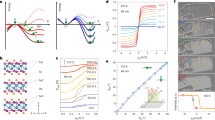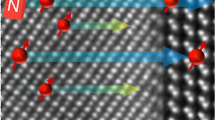Abstract
It is often assumed that it is not possible to alter the properties of magnetic materials once they have been prepared and put into use. For example, although magnetic materials are used in information technology to store trillions of bits (in the form of magnetization directions established by applying external magnetic fields), the properties of the magnetic medium itself remain unchanged on magnetization reversal. The ability to externally control the properties of magnetic materials would be highly desirable from fundamental and technological viewpoints, particularly in view of recent developments in magnetoelectronics and spintronics1,2. In semiconductors, the conductivity can be varied by applying an electric field, but the electrical manipulation of magnetism has proved elusive. Here we demonstrate electric-field control of ferromagnetism in a thin-film semiconducting alloy, using an insulating-gate field-effect transistor structure. By applying electric fields, we are able to vary isothermally and reversibly the transition temperature of hole-induced ferromagnetism.
This is a preview of subscription content, access via your institution
Access options
Subscribe to this journal
Receive 51 print issues and online access
$199.00 per year
only $3.90 per issue
Buy this article
- Purchase on Springer Link
- Instant access to full article PDF
Prices may be subject to local taxes which are calculated during checkout




Similar content being viewed by others
References
Prinz, G. A. Magnetoelectronics. Science 282, 1660–1663 (1998).
de Boeck, J. & Borghs, G. Magnetoelectronics. Phys. World 12, 27–32 (1999).
Ohno, H., Munekata, H., Penney, T., von Molnár, S. & Chang, L. L. Magnetotransport properties of p-type (In,Mn)As diluted magnetic III-V semiconductors. Phys. Rev. Lett. 68, 2664–2667 (1992).
Munekata, H., Zaslavsky, A., Fumagalli, P. & Gambino, R. J. Preparation of (In,Mn)As/(Ga,Al)Sb magnetic semiconductor heterostructures and their ferromagnetic characteristics. Appl. Phys. Lett. 63, 2929–2931 (1993).
Ohno, H. Making nonmagnetic semiconductors ferromagnetic. Science 281, 951–956 (1998).
Ohno, H. Properties of ferromagnetic III-V semiconductors. J. Mag. Magn. Mater. 200, 110–129 (1999).
Koshihara, S. et al. Ferromagnetic order induced by photogenerated carriers in magnetic III-V semiconductor heterostructures of (In,Mn)As/GaSb. Phys. Rev. Lett. 78, 4617–4620 (1997).
Munekata, H. et al. Diluted magnetic III-V semiconductors. Phys. Rev. Lett. 63, 1849–1852 (1989).
Soo, Y. L., Huang, S. W., Ming, Z. H., Kao, Y. H. & Munekata, H. III-V diluted magnetic semiconductor: Substitutional doping of Mn in InAs. Phys. Rev. B 53, 4905–4909 (1996).
Dietl, T., Ohno, H., Matsukura, F., Cibert, J. & Ferrand, D. Zener model description of ferromagnetism in zinc-blende magnetic semiconductors. Science 287, 1019–1022 (2000).
von Molnár, S., Munekata, H., Ohno, H. & Chang, L. L. New diluted magnetic semiconductor based on III-V compounds. J. Mag. Magn. Mater. 93, 356–364 (1991).
Shen, A. et al. Epitaxy and properties of InMnAs/AlGaSb diluted magnetic III-V semiconductor heterostructures. Appl. Surf. Sci. 113/114 183–188 (1997).
Chien, C. L. & Westgate, C. W. The Hall Effect and Its Applications 43–51 (Plenum, New York, 1980).
Arrott, A. Criterion for ferromagnetism from observations of magnetic isotherms. Phys. Rev. 108, 1394–1395 (1957).
Dietl, T., Haury, A. & Merle d'Aubigné, Y. Free carrier-induced ferromagnetism in structures of diluted magnetic semiconductors. Phys. Rev. B 55, R3347–R3350 (1997).
Lee, B., Jungwirth, T. & MacDonald, A. H. Theory of ferromagnetism in diluted magnetic semiconductor quantum wells. Phys. Rev. B 61, 15606–15609 (2000).
Fiederling, R. et al. Injection and detection of a spin-polarized current in a light-emitting diode. Nature 402, 787–790 (1999).
Ohno, Y. et al. Electrical spin injection in a ferromagnetic semiconductor heterostructure. Nature 402, 790–792 (1999).
Loss, D. & DiVincenzo, D. P. Quantum computation with quantum dots. Phys. Rev. A 57, 120–126 (1998).
Vrijen, R. et al. Electron-spin-resonance transistors for quantum computing in silicon-germanium heterostructures. Phys. Rev. A 62, 012306-1–10 (2000).
Acknowledgements
This work was supported by the Japan Society for the Promotion of Science, the Ministry of Education, Japan, and the Mitsubishi Foundation.
Author information
Authors and Affiliations
Rights and permissions
About this article
Cite this article
Ohno, H., Chiba, D., Matsukura, F. et al. Electric-field control of ferromagnetism. Nature 408, 944–946 (2000). https://doi.org/10.1038/35050040
Received:
Accepted:
Issue Date:
DOI: https://doi.org/10.1038/35050040
This article is cited by
-
Hard ferromagnetism in van der Waals Fe3GaTe2 nanoflake down to monolayer
npj 2D Materials and Applications (2024)
-
Magnetic properties of van der Waals ferromagnet \(\hbox {VI}_{3}\) and \(\hbox {CrI}_{3}\): a renormalization group approach
Indian Journal of Physics (2024)
-
Enhanced Room Temperature Ferromagnetism in Cobalt-Doped Copper Oxide Nanoparticles: Synthesis and Characterization
Brazilian Journal of Physics (2024)
-
Physical Properties of B12C4N8 Under the External Electric Field
Journal of Cluster Science (2024)
-
Ferromagnetism in two-dimensional metal dibromides induced by hole-doping
Scientific Reports (2023)
Comments
By submitting a comment you agree to abide by our Terms and Community Guidelines. If you find something abusive or that does not comply with our terms or guidelines please flag it as inappropriate.



